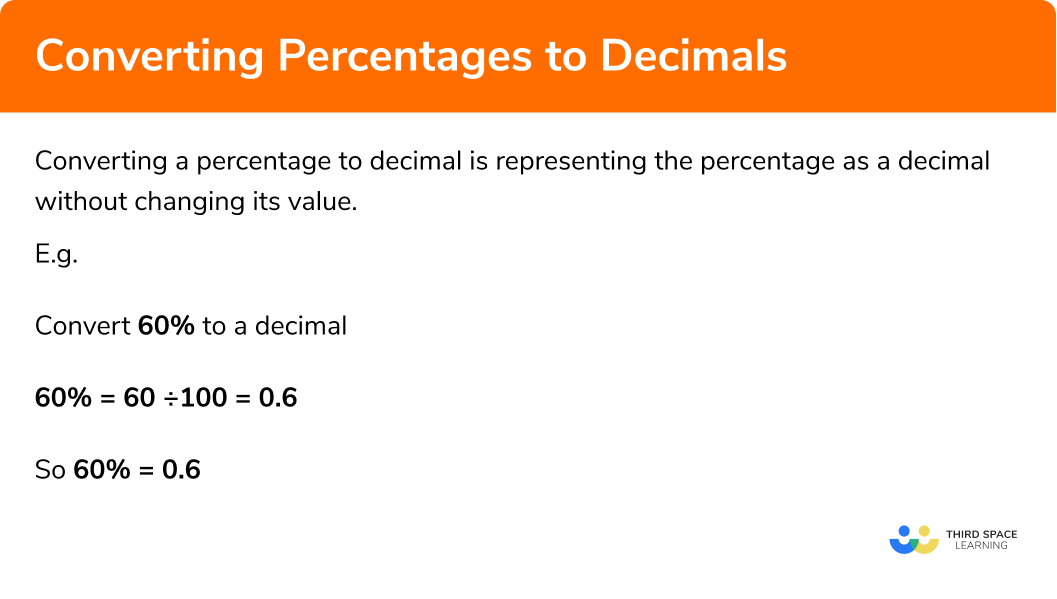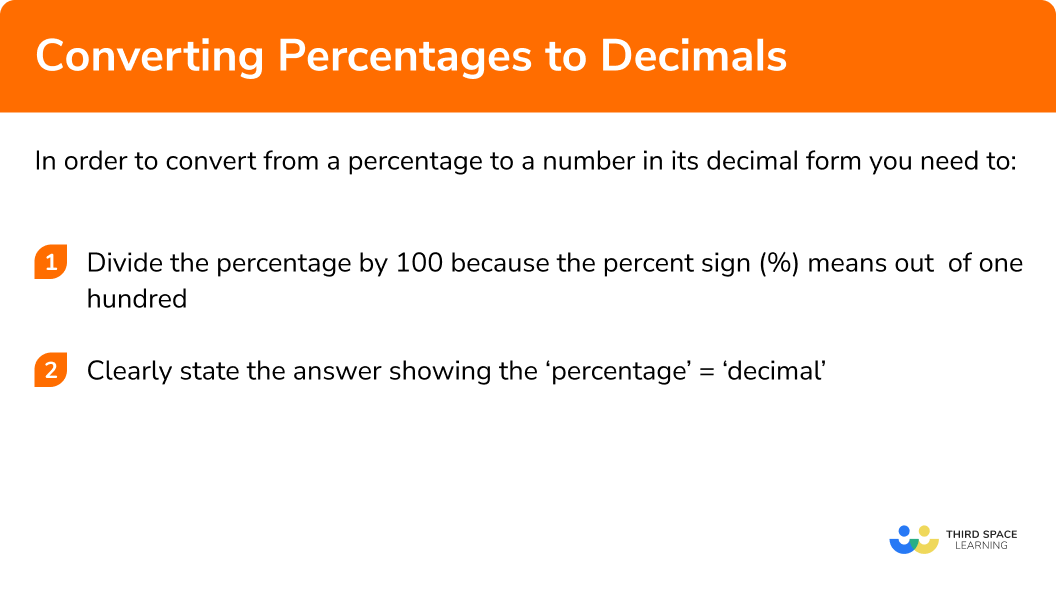One to one maths interventions built for KS4 success
Weekly online one to one GCSE maths revision lessons now available
In order to access this I need to be confident with:
Decimal to percentage Place value Arithmetic Simplifying fractions Equivalent fractions Improper fractions and mixed numbers FractionsThis topic is relevant for:

Percentage To Decimal
Here we will learn about converting percentages to decimals.
There are also converting percentages to decimals worksheets based on Edexcel, AQA and OCR exam questions, along with further guidance on where to go next if you’re still stuck.
What is converting percentages to decimals?
Converting a percentage to decimal is representing the percentage as a decimal without changing its value.
E.g.
What is converting percentages to decimals?

How to convert percentages to decimals
In order to convert from a percentage to a number in its decimal form you need to:
- Divide the percentage by \pmb{100} because the percent sign
(%) means out of one hundred. - Clearly state the answer showing the ‘percentage’ = ‘decimal’.
Explain how to convert a percentage to a decimal in 2 steps

To learn how to convert decimals to percentages check out:
Step by step guide: Decimal to Percentage

Percentage to decimal worksheet

Get your free percentage to decimal worksheet of 20+ questions and answers. Includes reasoning and applied questions.
DOWNLOAD FREE
Percentage to decimal worksheet

Get your free percentage to decimal worksheet of 20+ questions and answers. Includes reasoning and applied questions.
DOWNLOAD FREEConverting percentages to decimals examples
Example 1: converting a simple percentage to a decimal
Convert 60% to a decimal.
- Divide the percentage by a hundred since the percent sign (%) means out of \pmb{100}.
You know that the percentage sign (%) means the number is out of 100. Therefore if we divide the number by a hundred we will have the equivalent decimal.
When we divide by 100 we move the digits two places to the right.
The 6 has moved from the tenths column to the tenths column in the first decimal place.
The 0 has moved from the units column (ones column) to the hundredths column in the second decimal place.
The decimal point does not move.
2Clearly state the answer showing the ‘percentage’ = ‘decimal’.
Example 2: converting a simple percentage to a decimal
Convert 8% to a decimal.
Divide the percentage by a hundred.
Clearly state the answer showing the ‘percentage’ = ‘decimal’
Example 3: converting a percentage (involving a decimal) to a decimal
Convert 52.3% to a decimal.
Divide the percentage by a hundred.
Clearly state the answer showing the ‘percentage’ = ‘decimal’.
Example 4: converting a percentage (involving a recurring decimal) to a decimal
Convert 4.\dot{2} to a decimal.
Divide the percentage by a hundred.
Note: Remember the 2 is a recurring decimal. It will still be recurring indefinitely after being divided by 100.
E.g.
Therefore,
Clearly state the answer showing the ‘percentage’ = ‘decimal’.
Example 5: converting a percentage (above 100 ) to a decimal
Convert 145.1% to a decimal.
Divide the percentage by a hundred.
Clearly state the answer showing the ‘percentage’ = ‘decimal’.
Example 6: converting a percentage to a decimal
Convert 102.04% to a decimal.
Divide the percentage by a hundred.
Clearly state the answer showing the ‘percentage’ = ‘decimal’.
Calculator skills
Convert
- Insert the value of the percentage into your calculator.
- Divide by \pmb{100}.
- Press the
= button. Here your calculator will give the answer as a fraction in its simplest form. - Press the \pmb{[s ⇔ d]} button to have it shown as a decimal.
12% = 0.12
Common misconceptions
- Multiplying incorrectly by \pmb{100}
Often mistakes are made when dividing by 100. The common mistakes are:
− Dividing by 10 not 100.
− Multiplying instead of dividing.
− Making mistakes with decimals.
Make sure you are confident with the below calculations:
E.g.
- Recurring decimals in the percentages
You need to remember to take the recurring decimal into account when multiplying by an order of 10.
E.g.
Related lessons
Percentage to decimal is part of our series of lessons to support revision on comparing fractions, decimals and percentages. You may find it helpful to start with the main comparing fractions, decimals and percentages lesson for a summary of what to expect, or use the step by step guides below for further detail on individual topics. Other lessons in this series include:
Practice percentage to decimal questions
1. Convert 25\% to a decimal




25\% means 25 ÷ 100 which is equal to 0.25
2. Convert 87.5\% to a decimal




87.5\% means 87.5 ÷ 100 which is equal to 0.875
3. Convert 175\% to a decimal




175\% means 175 ÷ 100 which is equal to 1.75
4. Convert 760\% to a decimal




760\% means 760 ÷ 100 which is equal to 7.6
5. Convert 44. \dot{4}\% to a decimal




44.\dot{4}\% means 44.\dot{4} ÷ 100 which is equal to 0.\dot{4}
6. Convert 18.\dot{1}\dot{8}\% to a decimal




18.\dot{1}\dot{8}\% means 18.\dot{1}\dot{8} ÷ 100 which is equal to 0. \dot{1}\dot{8}
Percentage to decimal GCSE questions
1.
a) Convert 52\% to a decimal.
b) Convert 25\% to a decimal.
c) Convert 80\% to a decimal.
(3 marks)
a) 0.52
(1)
b) 0.25
(1)
c) 0.8
(1)
2.
a) Convert 250\% to a decimal.
b) Convert 160\% to a decimal.
c) Convert 20\% to a decimal.
(3 marks)
a) 2.5
(1)
b) 1.6
(1)
c) 0.2
(1)
3.
a) Convert 70\% to a decimal.
b) Convert 8\% to a decimal.
c) Convert 22. \dot{2}\% to a decimal.
(3 marks)
a) 0.7
(1)
b) 0.08
(1)
c) 0.\dot{2}
(1)
4.
a) Convert 101\% to a decimal.
b) Convert 16.\dot{6}\% to a decimal.
(2 marks)
a) 1.01
(1)
b) 0.1\dot{6}
(1)
Learning checklist
You have now learned how to:
- Convert percentages to a decimal
- Convert percentages (with a decimal) to a decimal
- Convert percentages (with a recurring decimal) to a decimal
The next lessons are
Still stuck?
Prepare your KS4 students for maths GCSEs success with Third Space Learning. Weekly online one to one GCSE maths revision lessons delivered by expert maths tutors.

Find out more about our GCSE maths tuition programme.